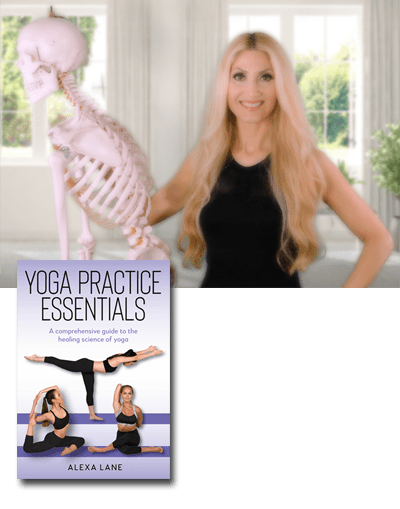Alexa Lane | Motivational Speaker and Author
Spirituality and Natural Healing
Yoga
The practice of yoga has many benefits. In simple terms, yoga practice aims to elevate the body, mind, and soul. It’s an integrative practice that is rooted in physical health, mental clarity, unconditional love, and happiness. Yoga practice can be further understood as a form of somatic healing that can help alleviate trauma that is stored in the body and mind. These practices help create a feeling of liberation and expanded awareness in the individual.
Physically, yoga postures can help you increase flexibility, increase lean body mass, and become stronger. On a mental and emotional level, the practices of deep breathing and meditation have a calming effect on the nervous system and improve your well-being.
Benefits include:
- Increase in Muscle Tone
- Weight Loss
- Injury Rehabilitation
- Lower Blood Pressure
- Increase in Bone Density
- Lower Heart Rate
- Lower Cortisol Levels
- Improvement in Sleep Quality
- Relief from Depression and Anxiety
Asana Practice
Asana is the third limb in the eight limb path of Raja Yoga. With respect to the idea of achieving “a steady, comfortable posture,” it’s important to approach asana practice as a way to create a balanced body and mind.
Asana is a great way to improve overall health and well-being in the body and mind by developing neuromotor skills, cardiorespiratory fitness, muscular strength and endurance, and flexibility. The key to a safe and therapeutic practice is to design a balanced sequence that does not overload any one area to the exclusion of another.
A holistic approach to asana, integrates the entire body and mind, so that all systems of the body work in harmony. Below, I have outlined the basic principles of fitness training and how to incorporate this training into asana practice. As you practice asana, bring your awareness to all aspects of your movement, the alignment of your body, and your breathing. Practicing with mindful awareness and a sense of calmness will help you receive the greatest benefits from your asana practice.
Remember, every human body is unique and beautiful, so the postures will look different depending on one’s physical capacity, body proportions, and the anatomical structure of the joints. Approach your asana practice with the understanding that asana is a therapeutic practice informed by modern science and designed to balance the body, mind, and overall energy.
Neuromotor Training
Neuromotor training, sometimes called “functional fitness,” refers to the relationship between the nervous system and movement. The benefits of neuromotor training include the development of motor skills such as coordination, gait, agility, proprioception, and balance. Exercises that build these skills become increasingly important as we age.
Practicing asana in a slow and precise manner offers many opportunities to build neuromotor skills by challenging the neuromuscular system. As you work on correcting your postural alignment, improving your balance, and moving more efficiently through space, you will slowly release postural misalignments. These misalignments may have caused pain, distress or unwanted compensatory movements.
Yogic Prescription for Neuromotor Training– Practicing one-legged balancing asanas is a great way to begin to develop these skills. Ideally, approaching your entire asana practice with conscious, kinesthetic awareness of your movements will bring about results.
Cardiorespiratory Training
Cardiorespiratory fitness refers to the ability to perform large muscle, dynamic, moderate to vigorous intensity exercise for a sustained period of time. Exercising at this level is dependent upon the integration of the respiratory, cardiovascular, and musculoskeletal systems combined with the physiologic and functional state of these systems. The idea is to increase the heart rate and respiration in order to challenge the cardiorespiratory system, thereby strengthening it. There are many benefits to training your cardiorespiratory system including decreased anxiety and depression, reduced resting systolic/diastolic pressures, reduced total body fat, and increased maximal oxygen uptake.
Yogic Prescription for Cardiorespiratory Training- To raise your heart rate and challenge the cardiorespiratory system, practice a sequence that links several asanas together for thirty minutes. Focus on breathing fully.
Muscular Strength and Endurance Training
Muscular strength refers to the ability of a muscle or muscle group to exercise force. Muscular endurance refers to the ability of a muscle or muscle group to continue to exercise without fatiguing. The benefits of muscular strength and endurance training include increases in strength, muscle mass, and bone density. The asanas are multi-joint exercises which present many opportunities to gain muscular strength and endurance.
Yogic Prescription Muscular Strength and Endurance- To build muscular strength in asana, actively engage the musculature to support your body in proper alignment during each asana. To build muscular endurance, perform a flowing sequence that links a variety of asanas together. It’s equally important to build both stability and mobility in your asana practice.
Flexibility Training
Flexibility is the ability of a joint to move through a full, pain free range of motion. The benefits of flexibility training include an increase in range of motion and the ability to better perform activities of daily living.
There are a wide variety of asanas that can help increase your range of motion and the overall flexibility of your body. As mentioned earlier, it is important to understand certain factors limit range of motion about a joint. Those factors include, age, gender, shape of the bones, ligament complex and joint capsule, muscles, fascia, tendons, and the skin.
Here are a few guidelines to help you safely stretch and practice asana:
- Warm up the body to increase core temperature before stretching.
- Perform each stretch in proper alignment.
- Work within average ranges of motion.
- Stay within a pain free active range of motion.
For more information on Yoga practice, you may purchase my book Yoga Practice Essentials
